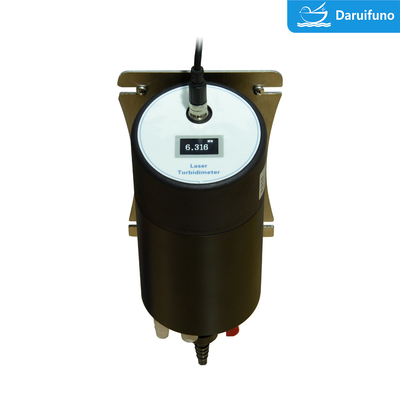Low Turbidity Flow-Through Digital RS485 Laser Turbidity Sensor With OLED Screen And Buttons Type For Drinking Water
The flow-through low turbidity sensor OLTU60 can be installed in the water flow pipeline to realize online and continuous monitoring without sampling to the laboratory for analysis. This sensor has great convenience and practicability in the process of drinking water treatment.
The OLTU6 flow-through low turbidity laser sensor for drinking water offers the following advantages:
High precision and sensitivity: This sensor uses laser light scattering technology, which can detect the presence of tiny particles, so it is very accurate for low turbidity water samples and can reflect small changes in water clarity.
Online real-time monitoring: flow-through low-turbidity laser sensors can be directly installed in water pipes or flowing water bodies to achieve online and continuous monitoring without sampling to the laboratory, saving time and cost.
Reagent-free and pollution-free: Traditional turbidity detection methods may require the use of reagents, while the flow-through low-turbidity laser sensor is a non-invasive detection technology that does not require reagent addition and avoids possible contamination problems caused by reagents.
Technical Parameters
| Model |
OLTU600 |
OLTU601 |
| Measuring Technology |
660nm Laser Scattering Principle |
| Measuring Range |
Turbidity: 0.001~100NTU
Temp: 0~45℃
|
| Resolution |
Turbidity: 0.001NTU
Temp: 0.5℃
|
| Accuracy |
0.001~40NTU is ± 2% of reading or ±0.015NTU, take the larger one; 40~100NTU is ± 5% of reading |
| Communication |
RS485 MODBUS-RTU |
| Display |
LED light |
OLED screen |
| Operation Panel |
Via PC or controller |
3 operation buttons |
| Response Time |
Step response, the initial response time<60 seconds |
| Related Measurement |
Temp measurement |
| Calibration Method |
Multi-point calibration; Contrast Offset; Factor offset |
| Sample Pressure |
Ensure that the sample pressure is 1~2bar before the injection port |
| Sample Flow Rate |
100~700mL/min, ideal flow: 200~300mL/min |
| Operating Temp |
0~45℃ (does not freeze) |
| Storage Temp |
-10~60℃ |
| Shell Material |
POM+nylon+ABS+stainless steel |
| Dimension |
140*140*330mm |
| Installation |
Main body wall mount |
| Lead interface |
M12 |
| Protection Grade |
IP65 |
| Power Supply |
9~18V DC |
| Power Consumption |
2.5W |
| Weight |
2100g |
User manual of OLTU600:
OLTU600 Low turbidity sensor user manual.pdf
Features
-
The flow turbidity sensor shoots the 660nm laser vertically downwards into the water. The light is scattered by suspended particles in the water sample, and the scattered light at 90°with the incident angle is received by the silicon photocell receiver immersed in the water sample, and 90° is calculated.
- Compact miniaturized design, small installation space
- 660nm laser light source with high resolution and fast response
- Optional viewing window and automatic emptying system reduce maintenance effort
- Low injection flow requirements, reducing the amount of waste generated in the measurement
- Internal storage of calibration data, support offline calibration, on-site plug and play

Drinking water flow-through low turbidity laser sensor OLTU60 is mainly used in environments related to drinking water treatment and monitoring. It aims to monitor the turbidity level of drinking water in real time to ensure safe and qualified water quality. The following are the main application environments for this sensor:
Drinking water production line: In the drinking water production line, the sensor can be installed at key positions in the process to monitor the turbidity of water samples in real time. This helps detect anomalies in the treatment process and if treatment needs to be adjusted to keep the water quality stable.
Waterworks: Waterworks are responsible for treating and supplying tap water to urban residents. The drinking water flow-through low turbidity laser sensor can be installed at the water inlet and outlet of the water plant to continuously monitor the turbidity changes of the raw water and the treated tap water. In this way, potential water quality problems can be detected in time, and measures can be taken to ensure that the drinking water supplied meets safe standards.
Water treatment facilities: In other types of water treatment facilities, such as sewage treatment plants, industrial wastewater treatment plants, etc., the sensor can also be applied. It monitors water quality changes during treatment and helps operators adjust and optimize treatment methods to meet treatment requirements and reduce environmental impact.
Drinking water quality monitoring station: Drinking water flow-through low-turbidity laser sensors can be deployed in drinking water quality monitoring stations in cities or communities for real-time monitoring of water quality in water supply systems. Such monitoring stations can provide continuous water quality data, provide decision-making basis for local governments and relevant departments, and ensure the safety of drinking water for the public.
In general, drinking water flow-through low turbidity laser sensors are widely used in all aspects of drinking water treatment and monitoring, aiming to provide high-precision, real-time water quality monitoring data to ensure the safety and qualification of drinking water and protect public health .

 Your message must be between 20-3,000 characters!
Your message must be between 20-3,000 characters! Please check your E-mail!
Please check your E-mail!  Your message must be between 20-3,000 characters!
Your message must be between 20-3,000 characters! Please check your E-mail!
Please check your E-mail! 









